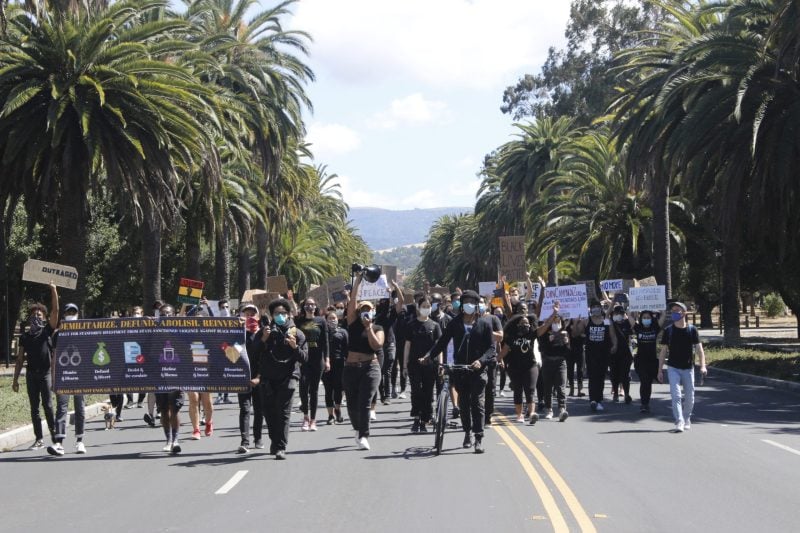Tuesday marked the first anniversary of the murder of George Floyd, an event that sparked a nationwide reckoning with race, Black Lives Matter protests across the world and renewed calls for social justice. In the months that followed, activists have made efforts to reform, defund and abolish the police, both on campus and beyond.
University administrators acknowledged this moment in an email to students on Tuesday, in which they recognized the gravity of Floyd’s death and encouraged readers to reflect on the impact of his death on the University, the nation and the world.
“Mr. Floyd was above all else a son and father, brother and cousin, friend and neighbor,” wrote Vice Provost for Graduate Education and Postdoctoral Affairs Stacey F. Bent Ph.D. ’92, Vice Provost for Student Affairs Susie Brubaker-Cole, Vice Provost for Undergraduate Education Sarah Church and Associate Vice Provost for Inclusion, Community and Integrative Learning Emelyn dela Peña. “Like too many others, he has also become a symbol of desperately needed disruption of the status quo.”
Over the past year, the Stanford administration has unveiled several initiatives for combatting racism on campus, but students criticize a lack of substantive change on some issues, such as policing on campus, and the need for significant student activism to make progress on others, such as the departmentalization of African and African American Studies.
Last summer, Stanford students jumped into organizing and activism after Floyd’s murder. Some joined local protests across the country. In late June, students created a memorial on the Stanford Oval composed of signs with the names and photos of over 100 Black individuals killed as a result of police brutality and racial violence. Just last month, students held a vigil after Derek Chauvin — Floyd’s murderer — was convicted of second-degree unintentional murder, third-degree murder and second-degree manslaughter.
“Our hope is we all understand Black Lives Matter is a part of a movement toward justice for Black people, which, in turn, means justice for all of us,” wrote Bent, Brubaker-Cole, Church and de la Peña. “May this day bring you time and space to reflect, listen and learn.”
After decades of activism by Black students and allies, a University task force recommended the departmentalization of the AAAS program in February. The AAAS program has existed at Stanford for over 50 years, and the Black Graduate Student Association (BGSA), the Black Student Union (BSU) and the Black Studies Collective worked together continuously to advocate for AAAS departmentalization. To BGSA organizer and first-year education Ph.D. student Darion Wallace, “the recommendation to departmentalize is only the beginning of a long road” — a sentiment shared by activists campus-wide.
“I feel honored to be able to celebrate this big win for Black Stanford students past, present and future; but this win came after 50-plus years of what I’d refer to as war with this institution to adequately support its BIPOC students, faculty and staff, and the school has miles and miles of acknowledgment, reckoning and reappropriating left to travel,” co-chair of the BSU Political Action Committee and chair of the Stanford Black Community Council John Okhiulu ’21 wrote in The Daily at the time.
Since Floyd’s murder, other University initiatives have included the establishment of a Center for Racial Justice at Stanford Law School, a promise to hire 10 new faculty members whose work was dedicated to studying the impact of race in America and the introduction of IDEAL Provostial Fellows.
According to Miranda, the University is working to “ensure that equity and inclusion are not just aspirations but a reality for each member of the Stanford community,” through other initiatives such as the Black Community Council, the Community Board on Public Safety, and the IDEAL Staff Advisory Committee. The University also unveiled a survey focused on diversity, equity, and inclusion this month that focuses on the experiences of various community members at Stanford.
In September, Green Library installed the Say Their Names – No More Names exhibition, which highlights the stories of 65 Black Americans who were killed or impacted by police brutality and systemic racism.
However, while moving forward with these plans, the University simultaneously worked on a $33.5 million project to create a Public Safety Building on campus. At a town hall for the Community Board on Public Safety last money, students condemned policing at Stanford and pushed for campus alternatives to the police.
“This community board and the university should invest in community building on campus, and not be spending millions of dollars on the police and building a new police station in the middle of a pandemic,” Caroline Kim ’21 said at the town hall.
Students, faculty and community members also called upon the University to increase its annual financial support for the King Institute through a petition that was signed by over 12,000 individuals. Since last summer, alumni and students donated over $100,000 to fund the Institute, though King Institute Director Clayborne Carson stated that they have not received additional funding from Stanford itself as of January.
